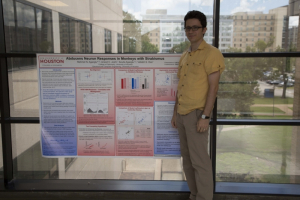If you think computer engineering, Rhesus monkeys and optometry have nothing in common, think again: they have Mehmet Agaoglu.
Agaoglu is a Ph.D. student in the electrical and computer engineering department at the UH Cullen College of Engineering who is researching strabismus (the disease which causes humans to go cross-eyed) in Rhesus monkeys at the College of Optometry, and now, his research is getting noticed on a national level. This spring, he won the members-in-training poster contest at the Association for Research in Vision and Ophthalmology’s annual conference for his strabismus research and corresponding poster. In fact, judges were so impressed with his abstract that they awarded him a travel grant to attend the ARVO conference for free.
As a Cullen College Ph.D. student, Agaoglu said he was introduced to the University of Houston’s College of Optometry when he began working there part-time as a programmer while he pursued his engineering doctorate. “Their research is in a very highly technical, computationally intense area,” he said. “Their work requires highly skilled engineering, because they have a lot of equipment and they need programming to make the devices talk to each other. So I went there and was able to program really quickly because I knew the concepts.”
After completing his programming work at the College of Optometry, Agaoglu said he was noticed by Vallabh Das, associate professor of optometry, and recruited to begin conducting actual strabismus research in the primate lab. Rhesus monkeys (sometimes known as macaques) are conditioned at a young age to develop the eye condition, and Das and his team then work to determine how to treat the underlying cause, which they believe to be the brain -- even though popular logic currently points to the eye muscles as the culprit.
“If you do corrective surgery [on a strabismus patient], they cut some of the muscles – they shorten them or stitch them somewhere else to behave as if they’re longer – but it only works in 40 percent of the cases. Most of the time the strabismus actually becomes worse and the patient ends up with worse vision… because [we think] the brain is adjusting its input to the muscles and pulling them back,” he said. To test their hypothesis, Das’ team records output from the different brain regions that control the eye muscles of the monkeys. “By recording these motor regions, we’re trying to show that the strabismic monkeys and normal monkeys have the exact same muscle and motor command properties, so the difference must be somewhere in the brain where the command originates.”
The scope of his strabismus research is staggering, but it’s actually just a side gig for Agaoglu. In pursuit of his computer engineering doctoral degree, he also studies “ballistic eye movements” under the direction of his advisor, Haluk Ogmen, professor of electrical and computer engineering. The human eye moves involuntarily at least three times per second in an effort to keep retinal images from fading or losing contrast. Agaoglu is performing computational experiments to determine how the brain accounts for these eye movements and processes the information in the scene.
He hopes to finish his Ph.D. soon and continue with post-doctoral work in optometry.
